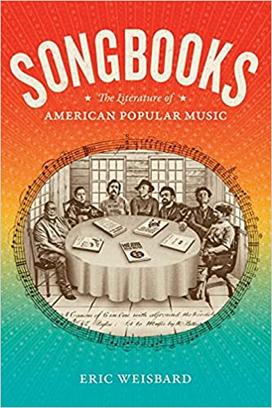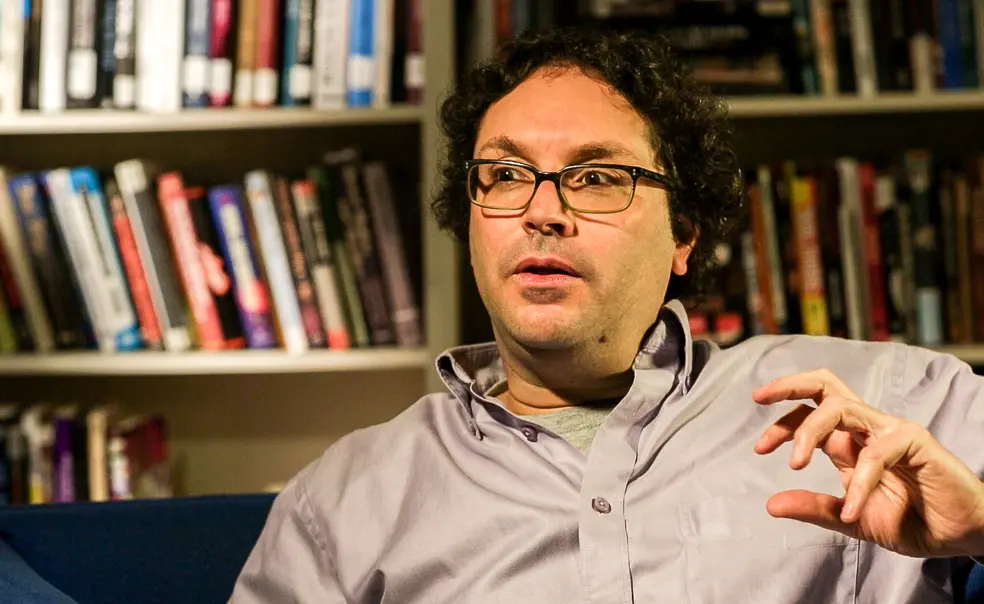Eric Weisbard ’88 Tracks American Music Evolution Through Writing
The book: Songbooks: The Literature of American Popular Music (Duke University Press) by Eric Weisbard ’88 compiles and critiques prominent American music writing on the most popular music through the decades. From William Billings' 1770 New-England Psalm-Singer to Jay-Z's 2010 memoir Decoded Weisbard connects memoirs, biographies, and song compilations to blues novels, magazine essays, and academic studies. This book was rooted in Weisbard’s desire to produce a comprehensive analysis of the development of American music through its writing. Through his research, Weisbard comes to realize the significance of fundamental questions asked decades ago and the unchanging relevance of song and music. Songbooks serves as a guide for anyone interested in understanding how we have digested and interpreted the most influential pieces of American music throughout history.

Excerpt: Popular music, that oddity of capitalism and the democratic rabble, has long made writers bend taste, language, and professional standards—anything to ping-pong back the relentless flow of smashes and spins. The industry, Isaac Goldberg punned in the 1930s, as he wrote the first history, was a racket: noise in the service of a hustle. Would you call Irving Berlin, king of the Tin Pan Alley sheet music trade, a composer? He could only play in one key. Yet he wrote hits, so authors wrote explanations. Algonquin Round Table member Alexander Woollcott heard in slurry come-ons like “Everybody’s Doin’ It Now” the city’s “alarum of the street cars,” slang’s “idiom of the sidewalks,” and song plugging’s relentless sales beat, “as much a part of the pace and rhythm of Berlin’s music as that music, itself, is part of the pace and rhythm of America.” Seventy years later, musicologist Charles Hamm detailed how Berlin songs gained middleclass legitimacy, himself legitimizing a topic that his discipline had led him to view as akin to pornography. Meanwhile, critic Jody Rosen pondered how the former Israel Baline wrote “White Christmas” and “Easter Parade,” gleeful to quote novelist Philip Roth on what Berlin’s assimilation did to goy holidays: “He deChrists them both!”
Songbooks: The Literature of American Popular Music aims to capture all of that sequence and more. It’s a critical guide to the authors, artists, and topics accruing a catalog as far back as William Billings’s 1770 New-England Psalm-Singer. The range of books makes an argument for intellectual history, comparable to pop’s implications for music history. You’ll find a blues novel by Gayl Jones and folk ballad mysteries by Sharyn McCrumb, memoirs by groupie Pamela Des Barres and industry figures Carrie Jacobs-Bond and Clive Davis, Top 40 charts books by Joel Whitburn and ragtime-era clippings collated by Lynn Abbott and Doug Seroff, glossy prose by Gilbert Seldes and Tom Wolfe. The provisional status of popular music authors, due to identity, funding, or creative obsession, shaped their output. Enduring stuff came from outsiders: women and/ or writers of color, authors displaced by sexuality or partial education, deviants from orthodoxy. Efforts to fix music’s meaning by discipline or genre have often meant less than a glimpse useful enough to pass around the way djs would a breakbeat, comparable to the verse a songwriter distills from experience to suggest a world.
I define popular music primarily around songs, America as both place and influence, literature as something that captivates as much as it informs. My entries are short: suggestive rather than definitive. And they proceed in the order of publication date for the book that launched the career or discourse, putting foundational texts near others in a period and letting them all quest forward. In popular music, new forms required new interpretations: think Bob Dylan’s Nobel Prize and the Is-he-literature? debate. Music writing’s preemptive verbiage line-cut more traditional scholarship. Since the 1990s, academics have created a more formal literature: studies that extended other studies, shared keywords, university press book series. That’s here, too. But professionalizing should not mean dismissing earlier writing. Hybridity and patched-together methods are not a weakness of popular music literature—they’re its essence. Rereading expansively can be as revisionist as wholly new exploration.
Books on music have come in a few dominant forms: collections of songs that showed a subject existed; critical, autobiographical, and fictional salvos attuned to the timbres of pop culture; genre and disciplinary codifications meant to set boundaries; and cultural studies revisionism challenging such norms. To taxonomize:
Collected works made a case even as they made a sale, arguments about value and immensity. Slave Songs of the United States credited Black musical originality. Morrison Foster’s 160-song collection sanctified his younger brother Stephen. John Lomax’s Cowboy Songs and Other Frontier Ballads alchemized “Home on the Range” into a Library of Congress folk division. Whitburn’s chart tallies valued commercial multiplicity.
As glossy magazines arrived, popular culture a staple, arts criticism supplied a tincture of modernity. Seldes of Vanity Fair tackled music within the “lively arts.” Langston Hughes wrote for a trade publisher. The new journalism of Wolfe extended into rock and rap prose. A similar flair for language and encapsulation characterized the best memoirs, star turns of unexpected emphasis for Sophie Tucker, Charles Mingus, Chuck Berry, Bob Dylan, Jay-Z. Links between new sounds and shifts in the fabric were often first explored by fiction writers, from F. Scott Fitzgerald and lesser-known Dorothy Baker on the jazz age to Andrew Holleran’s disco Dancer from the Dance. The desires of Sister Carrie met those of her later peers in Rolling Stone prodigy Cameron Crowe’s novel Fast Times at Ridgemont High. Ethnicity got its thickest musical description in Jessica Hagedorn’s Dogeaters and Los Bros Hernandez’s comic series Love and Rockets.
Through genre writing, peer groups delineated estimable musical approaches. A jazz lingo solidified, as in the writers’ collection Jazzmen or Nat Hentoff ’s multiartist synthesis Hear Me Talkin’ to Ya creating collective oral history. Rudi Blesh decreed ragtime’s worth. Samuel Charters and Paul Oliver foraged for blues. Charlie Gillett itemized rock and roll. Bill Malone put a honky-tonk- center on country music. Rock and soul countercultures stressed a more transgressive populism. Amiri Baraka’s Blues People voiced a funky perspective extended by Phyl Garland, Nelson George, and Greg Tate. Rock criticism came together in the Rolling Stone Illustrated History, Greil Marcus’s Mystery Train, and collections from Richard Meltzer, Ellen Willis, Robert Christgau, Lester Bangs, and Robert Palmer.
Academic disciplines separated popular music, too, but by methods of analysis. The contributors to H. Wiley Hitchcock’s New Grove Dictionary of American Music revamped musicology. Lawrence Levine brought folk laughter into American cultural history and archive digging into popular music writing. Bruno Nettl tracked the upstart field of ethnomusicology, raising comparative questions. Howard Becker and Richard Peterson fostered a sociology of culture, stressing institutions.
With Reagan and Thatcher in power and populist tastes no longer assumed progressive, cultural studies arrived, under Stuart Hall’s leadership. Dissecting assumptions rather than, as earlier, deepening them, the approach was brought into rock criticism by Simon Frith, folklore by Robert Cantwell, jazz academia by Robert O’Meally’s Columbia cohort, musicology by Susan McClary, ethnomusicology by Steven Feld, the African diaspora by Paul Gilroy, hip-hop by Tricia Rose, metal by Robert Walser, minstrelsy by Eric Lott, sound by Jonathan Sterne, Latinx scenes by Frances Aparicio, country by Diane Pecknold, Broadway musicals by Stacy Wolf. Similarly, fiction augmented the funky with the fantastic: the cyberpunk of William Gibson, future/past jumbles by Jennifer Egan. Post-boomer critics dug up once-deplored taste fringes: the poptimism of a Carl Wilson or Ann Powers, Alex Ross rooting classical in the popular sphere.
All of these approaches tended to overlap; another goal of this book is to put older work in conversation with those reworking it. William Billings was a young tanner when he self-published The New-England Psalm-Singer. In the 1955 America’s Music, Gilbert Chase heralded Billings as “a natural genius, a true primitive.” Richard Crawford, an early Ph.D. in American music, recast that in 1993’s American Musical Landscape, seeing a Billings who followed format rules. Those two scholars, getting U.S. popular sounds into music departments, left out the Billings who wrote sensationalist true-crime narratives akin to work by subsequent blackface minstrels like George Washington Dixon. Minstrels too had songbooks: a broadsheet of “Jim Crow” ran 150-plus verses. The dastardly versification obsessed the rock critic turned lore scholar W. T. Lhamon, who in staunch revisionism debuted the song’s author performer, T. D. Rice, on Harvard University Press more than a century after Rice’s death. Lhamon also reprinted Constance Rourke’s American Humor, 1930s speculation on minstrelsy as comic archetype.
Guthrie Ramsey Jr. worked at the junction of different traditions. His 2003 Race Music looked back to James Trotter’s 1878 Music and Some Highly Musical People, the first take on Black music by a Black writer. Ramsey, pivotal in brewing up antidotes to essentializing non-Black perspectives, also celebrated white amateur Dena Epstein, a librarian who spent a quarter-century paging pre-1860s primary sources to create a compilation, the 1977 Sinful Tunes and Spirituals. His scholarship involved considering his own family narrative, from the South to Chicago: why the funk Gap Band’s “Yearning for Your Love,” heard at his dad’s funeral, pushed against a music department urging him to concentrate on bebop pianist Bud Powell; why that raised issues of respectability you might take back to Alain Locke’s 1925 New Negro anthology, or put him in a contemporary conversation with the post-soul public sphere interventions of Mark Anthony Neal, the critical freaky-deke of critic Greg Tate, the abstruse but telling ontologies of poet-critical theorist Fred Moten.
These tales have the same moral. Professionalism was always in question, same as primitivism. That was American music. That was American music writing. And it’s all a very long story. Popular music involves not so much music and lyrics as music and the entire social and cultural field that supports and frames it. Writing that found a new way to chart an aspect of this universe, letting a part illuminate the whole, did most for our understanding. To ramble, haphazardly and gleefully, through books that predate us, is to realize that while such matters as commerce versus creativity, novelty versus classics, Blackness versus “Blackness” constitute core dialectics, popular and music remain the most fundamental intersection. Each word subsumes a panoply of selves and note-taking practices.
Review: “Embracing the fact that there’s no hearing any music without mediations of crosstalk, mythography, humbug, gatekeeping, and taste war, Eric Weisbard's exuberant and encyclopedic history of music writing delivers two and a half centuries of vernacular bounce—sheets of sound, if you will. Heroic, acutely discerning, compulsively readable, and bound to be enduringly useful.” — Eric Lott, author of Black Mirror: The Cultural Contradictions of American Racism












No responses yet